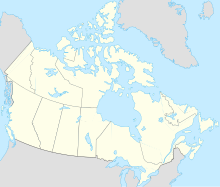Sable Island
|
Sable Island île de Sable |
|
|---|---|

Island from Space Shuttle, April 1994. Oriented clockwise through 225 degrees, i.e., north is in the lower left corner.
|
|
| Coordinates: 43°57′0″N 59°54′57″W / 43.95000°N 59.91583°WCoordinates: 43°57′0″N 59°54′57″W / 43.95000°N 59.91583°W | |
| Country | Canada |
| Province | Nova Scotia |
| Municipality | Halifax Regional Municipality |
| District | 13 |
| Area(Island) | |
| • Land | 34 km2 (13 sq mi) |
| Population (2008) | |
| • Total | 5 |
| • Density | 0.14/km2 (0.4/sq mi) |
| Time zone | AST (UTC-4) |
| • Summer (DST) | ADT (UTC-3) |
| GNBC Code | CBRQR |
| Sable Island | |||||||||||
|---|---|---|---|---|---|---|---|---|---|---|---|
| Summary | |||||||||||
| Airport type | Private | ||||||||||
| Owner | Parks Canada | ||||||||||
| Operator | Parks Canada | ||||||||||
| Location | Sable Island, Nova Scotia | ||||||||||
| Time zone | AST (UTC−04:00) | ||||||||||
| • Summer (DST) | ADT (UTC−03:00) | ||||||||||
| Elevation AMSL | 4 ft / 1 m | ||||||||||
| Coordinates | 43°55′46″N 059°57′35″W / 43.92944°N 59.95972°W | ||||||||||
| Map | |||||||||||
| Location in Canada | |||||||||||
| Helipads | |||||||||||
|
|||||||||||
|
Source: Canada Flight Supplement
|
|||||||||||
Sable Island (French: île de Sable) is a small island situated 300 km (190 mi) southeast of Halifax, Nova Scotia, and about 175 km (109 mi) southeast of the closest point of mainland Nova Scotia in the Atlantic Ocean. It is a year-round home to approximately five people, with summer numbers swelled by tourists, scientists, and others. Notable for the Sable Island horse, the island is protected and managed by Parks Canada. Permission must first be granted by it before anyone may visit. Sable Island is part of District 7 of the Halifax Regional Municipality in Nova Scotia. The island is also a protected National Park Reserve.
The expedition of Portuguese explorer João Álvares Fagundes explored this region in 1520–1521 and were among the first Europeans to encounter the island. It is likely that he named the island "Fagunda" after himself. An island called Fagunda appears on later Portuguese maps placed to the southeast of Cape Breton, fairly near its present location, however the identification of Sable Island with Fagunda is not certain. On the other hand, 16th century Portuguese sources describe a fishing colony founded by the navigator in the Cape Breton Island, further north. It is also possible that Fagundes sighted the island while heading southwest, reaching the Bay of Fundy, as the 1558 map of Diogo Homem and later Samuel de Champlain suggested, but this is unclear. A brief attempt at French colonization at the end of the 16th century using convicts failed. The island was inhabited sporadically by sealers, shipwreck survivors, and salvagers known as "wreckers."
A series of life-saving stations was established on Sable Island by the governor of Nova Scotia, John Wentworth, in 1801. The rescue station began the continuous human presence on the island which continues today. Wentworth appointed James Morris, a Nova Scotian veteran of the British Royal Navy as the first superintendent of the island. Morris settled on the island in October 1801 with his family. By the time Morris died on the island in 1809, he had built up the humanitarian settlement to include a central station, two rescue boat stations, several lookout posts and survivor shelters. The station's rescue equipment was upgraded in 1854 with the latest generation of self-bailing lifeboats and life cars through the fundraising efforts of social reformer Dorothea Dix who had visited the island in the previous year.
...
Wikipedia

